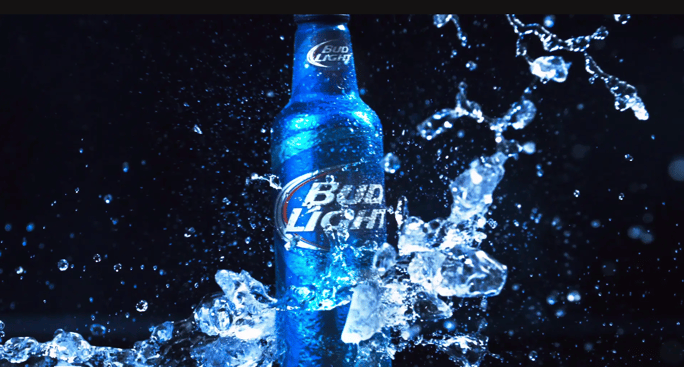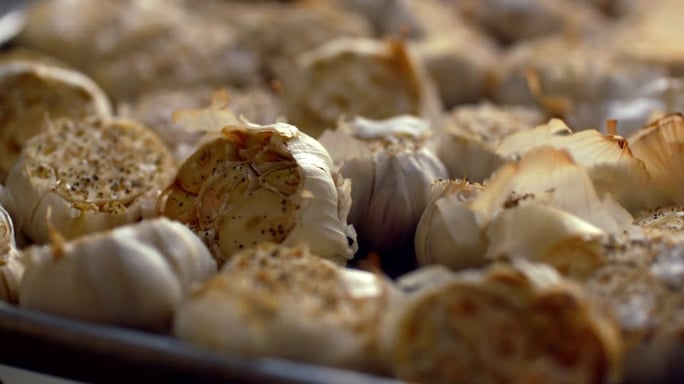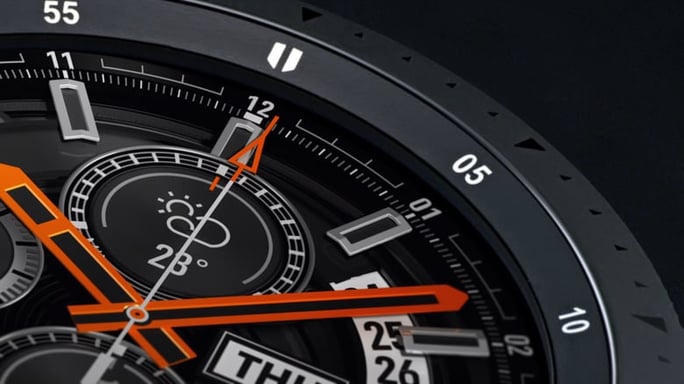Irv Blitz is a director, but he doesn’t work with actors. Instead, he draws out dynamic performances from slices of pizza and cups of coffee. A pioneer of the advertising niche known as “tabletop,” Blitz uses macro-photography to create a kind of moving still-life. Clients such as Samsung, Levi’s, and Pizza Hut hire Blitz to bring their inanimate products to life. In each spot, he builds out a visual language using mostly close-ups, focusing on the details of an object and moving it through space to create a narrative. Blitz is a mastermind of kinetic advertising; his spots are almost like dances of inanimate things.
“I romanticize things,” Blitz told Assemble. “I make familiar things spectacular with action and with movement.” In the interview, Blitz also discusses what’s changed across his four decades of experience in advertising, how he rejected the old “fake advertising” in favor of a realism aesthetic, and more.
Assemble: You run a studio that you started as a one-man-band and has now grown into a bona fide brand of advertising, called “tabletop.” How did it all begin?
Blitz: I’m a director-cameraman. So, I direct and film all of my own work. I’ve been doing this now for 35 years, so I’m well-seasoned in this industry. But even though I might have all of this experience, it’s still a remarkable business to me. I approach every project with fresh eyes and an open mind, and I really try not to repeat myself. I try to reinvent as much as I can.
Assemble: Can you tell me the story of how you grew your studio, from when you first started out to now?
Blitz: Well, when I first started shooting, product photography was like food photography—it was a type of advertising. It was always a niche, but people looked at it differently. It wasn’t the kind of advertising that inspired higher-end commercials.
So, when I came into it, I was determined to create the most innovative [version of it]. I started off as a still-life photographer. So many famous painters and sculptors have been inspired by the marvelous quality of the still-life. I wanted to bring that same artistic rendition of objects to advertising. Whether it’s a cereal box or a bowl of fruit or a piece of pizza, I thought, “Here’s my opportunity to make these things look amazing.”

That’s what I know how to do: I know how to look at something and say, what is interesting about this? What makes it beautiful? What makes it appealing to me? With an inanimate object, you have to put some of your own self into it to make it appealing. That’s been the general objective of all my work over these years—to make objects look interesting, and to create movement and design that’s interesting and relatable.
Of course, it’s advertising. The goal is to make money for a client. The goal is to sell whatever you’re selling. So, it’s really important that not only I like it, but that so many other people can relate to it, and go, “Wow, that’s really cool.” Or, “Gosh, that piece of pizza looks delicious. I want to eat it.” That’s how you know it’s been successful—when your client’s sales go up, and you have this relationship to the imagery you made. It’s a very interesting correlation between art and business.
Assemble: You talked about putting yourself into the shoots. In which specific ways do you do that? Maybe you can give me an example with regard to a recent campaign.

Blitz: Well, I love shooting beer. Let’s pick beer, for instance. What do I like about beer? I like beer cold. I like it to be fresh. I like the bubbles moving. I like condensation on the glass. So, I make sure that all the beer that I shoot is extremely cold. I like it to look like it’s cold and refreshing, and not by faking it to look cold and refreshing.
The interesting thing about all the [advertising] before my generation was that everything was really done in a very fake way. Instead of chilling the beer bottle and making it look cold, people would take glycerine, which is a lubricant that beads up like water, and they’d spray the bottle to make it look cold. So, advertising from the ‘50s, the ‘60s, the ‘70s, and the ‘80s was this idealistic dream of what something should look like.
I started in the late ‘80s, and I decided, “No, I don’t want it to look idealistic. I want it to look real. I want to eat it, I want to drink it, I want to touch it.” So, I built my aesthetic around realism. I used real ice cubes. Real ice cream. I shot cold beverages, foods you can eat.
It’s been a real process—decades long. Finally, everyone’s embracing this aesthetic. But it’s been a long road. I mean, people say they want that perfect/imperfect look. But then, “Why are we spending two hours building a burger? It doesn’t take you two hours to cook and make a burger.” Or, “Why are we doing food architecture instead of real food?”
To get everyone on the same page as me, I’ve had to work with a lot of people who also [share] my aesthetic—people who were willing to throw out the old and bring in the new.
Assemble: What has changed in terms of technical challenges and demands over the years you’ve worked in advertising?
Blitz: When I started, we shot on film. Now, everything, of course, we shoot on video.
Film was so magical. You shoot something, you get a latent image, you close it, you develop it. You think you know what you’re going to get, but until you see it developed and printed, you don’t know what you have. With video, you see it immediately. It’s instant gratification. I always thought you were going to lose the magic of making an image with digital. But you don’t—instead, you’re able to craft the image right then and there in the process.
For years, I’ve worked to make my video imagery look very much like cinematic film imagery. Now, you can’t tell the difference. In fact, for years, I shot with a film camera and a digital camera when I was making the transition. I shot them both so I could see what the difference was and try to merge the look.
Another thing that’s changed: the budgets. You have to work very fast. Back in the ‘80s and ‘90s, we shot five shots a day. Then, it became 10 shots a day. Then, it became 15 shots a day. Now, it could be anything between 20 and 40 shots a day, depending on whether we’re on location or in the studio. So we have to produce so much more imagery, so much faster.

Assemble: Has anything changed about the creative demands of the clients?
Blitz: All of the time, clients say, “I love what you do. I want to see what’s next. What can you do more? Show me something you’ve never done before.” That’s always a client or an agency request.
Assemble: That is a tall order.
Blitz: It’s a very tall order.
The other day, I was shooting for Pizza Hut. It was a Meat Lover’s pizza, so they really wanted to show off the meat. I created this imagery of the pizza moving through space. It was the crust moving through the frame, and then revealing the toppings. We cut to an overhead shot of the toppings falling away, and to other close-up shots of cheese pulls.
Then, the client said to me, “What can we do to show the entire slice of pizza?”
I thought, “What if I just bring the slice up into frame? What if I toss it up?” I don’t like to do flying food, because flying food is not real. But, in a spot where you’re highlighting toppings, you have to use other methods—I don’t want to say sensational tricks, but you have to use other methods.
So, I asked myself, “What is the best way to photograph this slice that also has some element of the reveal?” And I thought, “Wouldn’t it be cool if the slice comes up into frame? We’ll have the toppings reveal themselves.”
I decided to use an extremely wide-angle lens. It’s a close-focusing lens, like a 16 millimeter. You would never use that lens in a studio. It’s a landscape lens. It’s certainly not a typical lens you would use to shoot food.
So, I pop the lens on, and I hold the pizza where I want it to land in frame. The wide-angle nature of the lens made the slice look enormous. It made it look impressive. A little bit of that barrel distortion that you get with a wide-angle lens made it look even more beautiful. I had a little rig that kind of set the pizza up into frame so it would just hover for a second before it descended.
That was the moment I wanted. Where the camera is saying, “Look at this beautiful piece of pizza. Look how delicious this looks.” Simple as that. It really came together.
Assemble: Who is on your team while you’re shooting this slice of pizza? Who’s doing what on set?
Blitz: It’s a collective of people. It takes, like, 50 people. It’s amazing what it takes to shoot a piece of pizza!
I’ve got to have all my crew to do tests. I need my rig guy to see how high or low the pizza goes, and to set up the camera correctly. Since we’re shooting a thousand frames per second, you have to have the lighting right.
There are 10 food stylists on the team. The client sends cases and cases of food. They sort it all, they prepare it, they cook it. The stylists have to make the slice look like it just came out of the pie—where the cheese is falling over, and the meat looks delicious. When I’m shooting pizza, I want the pizza hot. I want the pizza right out of the oven. You don’t want to shoot a cold piece of pizza. So, as the pizza is popping up into frame, we have to come in with our heating element, get it sizzling, get the cheese bubbling a little bit, get the pepperonis crispy, get the sausage to sizzle.
One thing I’ve learned about working with clients is when they’re happy, move on. For example, the first piece of pizza came up into frame, and the client was thrilled. She was so ecstatic. I wasn’t so much, because it was a little bit unfocused—I was shooting with such depth of field. It was slightly soft, but only to me.
They were happy with where I was with one take. It’s me who says, “I think I could do this better.” Clients want to move on. They want to get their extra shots. They don’t want me to shoot 20 takes, or even two takes out of the same thing. If they’re happy, they say, let’s move on. So, I have to let that stuff go.

Assemble: Do you work with the editor directly? Are you sitting in on the edit?
Blitz: I do a rough edit while I’m shooting. l play the video assist. I sit with him and our script supervisor and I select the takes. I give them the in and out.
I don’t usually sit with the editor, because that’s a long process. The editor really takes their time going through all the footage, looking at takes. But we give the editor, in our script notes, very specific takes. We give them options—two or three takes of a similar thing, so that they can decide which one works best for them, timing-wise.
Clients like that I edit while I shoot. Of course, it’s just a string of images that we’ve put together, and it’s much longer than a 30-second spot. But I like to show them how, sequentially, the images will come together. They go, “Oh, I get it. This looks great.” There’s no question of whether it works or doesn’t work, or whether we need a different framing. When you’re dealing with a group of clients and several agencies, it’s great to be able to give them that degree of certainty. They’re getting what they paid for.
Assemble: Do you work with any VFX?
Blitz: Oh yes, of course. But I try not to make things too tricky.
I’ll tell you, the best rigs are done by hand. Every single time you do it, it’s going to be slightly different. I prefer that. I like the mistakes to happen. The mistakes—or the things that I sometimes consider my worst work—are sometimes what the editor uses. And then I go, “Oh my god, look at how great that looks!” Sometimes, editors will even use the test footage take!
So again, I try not to rig, but when I do rig, I try to rig for it to be predictable in some aspects, but unpredictable in others. I try to rig for something that happens that’s really unique to each take—that happy accident.
Assemble: For someone who wants to capture the texture of reality, it makes much more sense to do it all practically.
Blitz: It’s way more exciting. It’s much more work, but it makes the final shot way more interesting.
Assemble: I’m impressed with how kinetic your spots feel. I was wondering if you could talk to me about how you cheat the camera to capture movement in macro.
Blitz: When you’re working with something small, and you’re working in such high magnification, you can’t move around it. For example, I shoot a lot of jewelry. You can’t move a diamond around like you move a car. You can’t shoot a person the same way you shoot a bagel close up.
Dynamic movement is so important with inanimate objects. Either you can just record the object and say, “Look at this beautiful bracelet,” or you can drop the bracelet onto a surface, and let it land, and the gemstones sparkle and reflect onto the surface. You can kind of romanticize things—make familiar things spectacular with action and with movement. That’s so much more emotionally compelling to the viewer. This is advertising. I want someone to look at something and inherently want it.
So, then you have to think about how to string all of these images together to make a cohesive film. Because it’s not just images strung together—it’s a sequence that tells a mini-story. That’s always an interesting challenge.

In my career, I’ve been able to do a lot of different kinds of work. I can do work that’s very precision-oriented, like ads for phones, computers, appliances, things of that nature. These clients require a more technical approach.
But with something like food, you want it to be more fluid. Maybe you’re shooting a family having a holiday dinner together. You want it to have a different energy. So, you really just have to find that sequence that gives you that little story. You have to find the movement and camera angles that give you that kinetic energy. And when that’s successful, it’s really satisfying.

